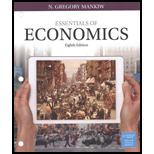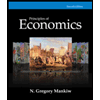
Sub part (a):
Nominal
Sub part (a):
Explanation of Solution
The GDP is the summation of the money value of all the goods and services produced within the political boundary of a country within a financial year. There are two different ways of calculating the GDP of the economy and they are the Real GDP and the Nominal GDP. The Real GDP is the GDP calculated at the constant prices. There will be a base
The nominal GDP of the economy can be calculated by multiplying the quantity produced by the per unit price of the commodity. The quantity produced and price in year 1 were 3 bars of chocolate and the price was $4. Thus, the Nominal GDP of year 1 can be calculated as follows:
Thus, the Nominal GDP of year 1 is $12.
Similarly, the quantity produced and price in year 2 were 4 bars of chocolate and $5 respectively. Thus, the Nominal GDP of year 2 can be calculated as follows:
Thus, the Nominal GDP of year 2 is $20.
The quantity produced and price in year 3 were 5 bars of chocolate and $6 respectively. Thus, the Nominal GDP of year 3 can be calculated as follows:
Thus, the Nominal GDP of year 3 is $30.
Concept introduction:
Gross Domestic Product (GDP): It is the summation of the money value of all the goods and services produced within the political boundary of a country within a financial year.
Nominal GDP: The Nominal GDP is the GDP calculated at the current prices.
Sub part (b):
Real GDP.
Sub part (b):
Explanation of Solution
The base year is year 1 and thus, the real GDP and the Nominal GDP of the year 1 will be the same and thus, the Real GDP of year 1 will be equal to the Nominal GDP of year 1 which is $12.
The quantity produced and price in year 2 were 4 bars of chocolate and the base price was $4. Thus, the Real GDP of year 2 can be calculated as follows:
Thus, the Real GDP of year 2 is $16.
The quantity produced and price in year 3 were 5 bars of chocolate and the base price was $4. Thus, the Real GDP of year 3 can be calculated as follows:
Thus, the Real GDP of year 3 is $20.
Concept introduction:
Gross Domestic Product (GDP): It is the summation of the money value of all the goods and services produced within the political boundary of a country within a financial year.
Real GDP: The Real GDP is the GDP calculated at the constant prices. There will be a base price index and the value of goods and services that will be calculated on the base of the constant prices. Thus, it will measure the GDP of the economy on the same base year price index which will help us to identify the inflation in the economy.
Sub part (c):
GDP deflator.
Sub part (c):
Explanation of Solution
The GDP deflator is the implicit price deflator. It can be calculated by dividing the Nominal GDP with the Real GDP and multiplying the value with 100 as follows:
Thus, by substituting the values of Nominal and Real GDP in the equation, we can calculate the GDP deflator as follows:
Thus, the GDP deflator in Year 1 is 100. Similarly, the GDP deflator for year 2 can be calculated as follows:
Thus, the GDP deflator in Year 2 is 125.
The GDP deflator for year 3 can be calculated as follows:
Thus, the GDP deflator in Year 3 is 150.
Concept introduction:
Gross Domestic Product (GDP): It is the summation of the money value of all the goods and services produced within the political boundary of a country within a financial year.
GDP deflator: It is an implicit price deflator.
Sub part (d):
Growth of Real GDP.
Sub part (d):
Explanation of Solution
The growth rate of Real GDP from year 2 to year 3 can be calculated by the following formula:
Thus, the growth rate of Real GDP from year 2 to year 3 is by 25 percent.
Concept introduction:
Gross Domestic Product (GDP): It is the summation of the money value of all the goods and services produced within the political boundary of a country within a financial year.
Real GDP: The Real GDP is the GDP calculated at the constant prices. There will be a base price index and the value of goods and services that will be calculated on the base of the constant prices. Thus, it will measure the GDP of the economy on the same base year price index which will help us to identify the inflation in the economy.
Sub part (e):
Growth rate of inflation.
Sub part (e):
Explanation of Solution
The inflation rate is the rate at which the inflation rose in the economy. The inflation rate can be calculated using the GDP deflator as follows:
Thus, the growth rate of inflation from year 2 to year 3 is by 20 percent.
Concept introduction:
Gross Domestic Product (GDP): It is the summation of the money value of all the goods and services produced within the political boundary of a country within a financial year.
Inflation: It is an increase in the general price level of goods and services in an economy over a period of time.
Sub part (f):
Growth rate of Real GDP and inflation rate.
Sub part (f):
Explanation of Solution
The growth rate of the real GDP can be calculated with the help of the percentage change in the quantity because the price is base price which is fixed and does not change. Similarly, in the case of calculation of the inflation rate, the percentage change in the price of the commodity could be measured.
Concept introduction:
Gross Domestic Product (GDP): It is the summation of the money value of all the goods and services produced within the political boundary of a country within a financial year.
Real GDP: The Real GDP is the GDP calculated at the constant prices. There will be a base price index and the value of goods and services that will be calculated on the base of the constant prices. Thus, it will measure the GDP of the economy on the same base year price index which will help us to identify the inflation in the economy.
Inflation: It is an increase in the general price level of goods and services in an economy over a period of time.
Want to see more full solutions like this?
Chapter 15 Solutions
Bundle: Essentials Of Economics, Loose-leaf Version, 8th + Lms Integrated Mindtap Economics, 1 Term (6 Months) Printed Access Card
- You are the manager of a large automobile dealership who wants to learn more about the effective- ness of various discounts offered to customers over the past 14 months. Following are the average negotiated prices for each month and the quantities sold of a basic model (adjusted for various options) over this period of time. 1. Graph this information on a scatter plot. Estimate the demand equation. What do the regression results indicate about the desirability of discounting the price? Explain. Month Price Quantity Jan. 12,500 15 Feb. 12,200 17 Mar. 11,900 16 Apr. 12,000 18 May 11,800 20 June 12,500 18 July 11,700 22 Aug. 12,100 15 Sept. 11,400 22 Oct. 11,400 25 Nov. 11,200 24 Dec. 11,000 30 Jan. 10,800 25 Feb. 10,000 28 2. What other factors besides price might be included in this equation? Do you foresee any difficulty in obtaining these additional data or incorporating them in the regression analysis?arrow_forwardsimple steps on how it should look like on excelarrow_forwardConsider options on a stock that does not pay dividends.The stock price is $100 per share, and the risk-free interest rate is 10%.Thestock moves randomly with u=1.25and d=1/u Use Excel to calculate the premium of a10-year call with a strike of $100.arrow_forward
- Please solve this, no words or explanations.arrow_forward17. Given that C=$700+0.8Y, I=$300, G=$600, what is Y if Y=C+I+G?arrow_forwardUse the Feynman technique throughout. Assume that you’re explaining the answer to someone who doesn’t know the topic at all. Write explanation in paragraphs and if you use currency use USD currency: 10. What is the mechanism or process that allows the expenditure multiplier to “work” in theKeynesian Cross Model? Explain and show both mathematically and graphically. What isthe underpinning assumption for the process to transpire?arrow_forward
- Use the Feynman technique throughout. Assume that you’reexplaining the answer to someone who doesn’t know the topic at all. Write it all in paragraphs: 2. Give an overview of the equation of exchange (EoE) as used by Classical Theory. Now,carefully explain each variable in the EoE. What is meant by the “quantity theory of money”and how is it different from or the same as the equation of exchange?arrow_forwardZbsbwhjw8272:shbwhahwh Zbsbwhjw8272:shbwhahwh Zbsbwhjw8272:shbwhahwhZbsbwhjw8272:shbwhahwhZbsbwhjw8272:shbwhahwharrow_forwardUse the Feynman technique throughout. Assume that you’re explaining the answer to someone who doesn’t know the topic at all:arrow_forward
 Essentials of Economics (MindTap Course List)EconomicsISBN:9781337091992Author:N. Gregory MankiwPublisher:Cengage Learning
Essentials of Economics (MindTap Course List)EconomicsISBN:9781337091992Author:N. Gregory MankiwPublisher:Cengage Learning Brief Principles of Macroeconomics (MindTap Cours...EconomicsISBN:9781337091985Author:N. Gregory MankiwPublisher:Cengage Learning
Brief Principles of Macroeconomics (MindTap Cours...EconomicsISBN:9781337091985Author:N. Gregory MankiwPublisher:Cengage Learning Principles of Economics, 7th Edition (MindTap Cou...EconomicsISBN:9781285165875Author:N. Gregory MankiwPublisher:Cengage Learning
Principles of Economics, 7th Edition (MindTap Cou...EconomicsISBN:9781285165875Author:N. Gregory MankiwPublisher:Cengage Learning Economics (MindTap Course List)EconomicsISBN:9781337617383Author:Roger A. ArnoldPublisher:Cengage Learning
Economics (MindTap Course List)EconomicsISBN:9781337617383Author:Roger A. ArnoldPublisher:Cengage Learning
 Principles of Economics (MindTap Course List)EconomicsISBN:9781305585126Author:N. Gregory MankiwPublisher:Cengage Learning
Principles of Economics (MindTap Course List)EconomicsISBN:9781305585126Author:N. Gregory MankiwPublisher:Cengage Learning





